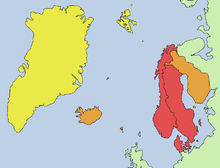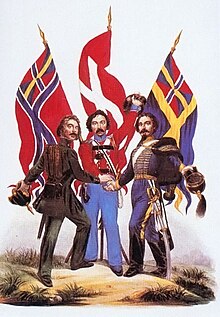斯堪的纳维亚
| 本条目需要擴充。(2017年6月6日) |
| 系列条目 |
| 斯堪的纳维亚 |
|---|
 |
地理 |
|
維京時代 |
|
政治實體 |
|
歷史 |
|
其他 |
|
| 「Skandinavien」的各地常用別名 | |
|---|---|
| 中国大陸 | 斯堪的纳维亚 |
| 臺灣 | 斯堪地那維亞 |
| 港澳 | 斯堪的納維亞 |
斯堪的纳维亚(丹麥語、瑞典語:Skandinavien,挪威語:Skandinavia,薩米語:Skadesi-suolu、冰島語:Skandinavía),又譯斯堪地那维亚,在地理上是指斯堪的納維亞半島,包括挪威和瑞典,文化与政治上則包含丹麦[1][2]。這些國家互相視對方屬於斯堪的纳维亚,雖然政治上彼此獨立,但共同的稱謂顯示了其文化、語言和歷史有深厚的淵源。

紅色部分:根據最嚴格定義之斯堪的纳维亚國家(三個君主立憲國);橙色部分:可被視為屬於斯堪的纳维亚的國家;黃色部分:最寬鬆的定義,與紅色和橙色部分統稱北歐國家
芬蘭、冰島和法羅群島等北歐國家因其與丹麥、挪威和瑞典相近的歷史和文化背景,有時也被視為斯堪的納維亞國家[3][4][5][6]。有時這些對斯堪的納維亞的不同理解可能會引起不滿,「北歐國家」(Nordics)才是對北歐五個國家的合宜統稱。
目录
1 字源
2 語言
3 政治
4 参考文献
5 外部链接
6 参见
字源
斯堪的納維亞的字源被認為與瑞典舊省之一斯科訥相同,都源自原始日耳曼語的合成詞「Skaðin-awjō」[7],但兩詞來源的說法不一。最早出現此名稱,係見於古羅馬作家老普林尼著作《博物誌》。「Skaðan」可解釋為「危險」為「危害」[8],「awjō」則可釋義為「水上土地」或「島嶼」。另有說法與北歐神話人物絲卡蒂有關[9]。
語言
大部分丹麥語、瑞典語和挪威語的方言是大致互通的,斯堪的納維亞人能夠理解彼此的標準語言。芬蘭語和愛沙尼亞語屬芬兰-乌戈尔语系,與斯堪的納維亞的語言(丹麥語、瑞典語和挪威語)不同,比較接近匈牙利語。
政治

反映憧憬統一斯堪的納維亞的政治漫畫(19世紀)
斯堪的納維亞一詞現代的用法源自19世紀中葉的「斯堪的納維亞政治運動」。該運動於瑞-挪王國和丹麥與普魯士和什勒斯維希-荷爾斯泰因之間爆發的第一次什勒斯維希戰爭(1848年-1850年)與及第二次什勒斯維希戰爭 (1864年)期間最為活躍。瑞-挪王國最初投入了相當大的軍力支援丹麥,但瑞典議會其後拒絕向國王提供軍力,斯堪的納維亞政治運動無疾而終。
當時瑞典國王卡爾十四世提倡把丹麥、瑞典和挪威統一成一個王國。這個提議的起因是19世紀初,受到拿破崙戰爭所引發的動盪影響所造成的分裂:瑞典的東部地區在1809年變成俄羅斯芬蘭大公國,而打從1387年與丹麥聯合的挪威則是在1814年獨立,雖然它很快又被迫與瑞典成為君合。
芬蘭成為俄羅斯帝國的一部分意味著它不可能與北歐諸國在政治上結盟。所以「斯堪的納維亞」一詞在地理上包括瑞典、挪威和芬蘭的一部分,但政治上「斯堪的納維亞」還包括丹麥。政治上來說,瑞典與挪威以共主邦聯的形式被同一個王室統治。丹麥的附屬地包括大西洋上的冰島,法羅群島和格陵蘭(雖然歷史上來說,格陵蘭屬於挪威,但是根據基爾條約,它一直由丹麥治理。)
瑞典-挪威王國在第一次戰爭中支援丹麥。不過,當瑞典-挪威王國其後拒絕軍事支援丹麥去併吞丹麥裔的什勒斯維希公國,統一斯堪的納維亞的政治運動便宣告結束。什勒斯維希公國與德裔的荷爾斯泰因公國與丹麥屬於同一個共主邦聯。接著,1864年,丹麥與受到奧地利帝國支持的普魯士帝國之間發生了第二次什勒斯維希戰爭。戰爭期間很短但是損失很大。什勒斯維希-荷爾斯泰因被普魯士征服。當普魯士打贏普法戰爭後,它建立了德意志帝國,改寫了波羅的海的勢力平衡。
雖然斯堪的納維亞的大一統始終不能實現,早於1873年斯堪的納維亞金融聯盟正式成立,克朗成為共同貨幣直至第一次世界大戰。
一戰後,斯堪的納維亞的合作關係包括了獨立的芬蘭,從1944年開始還包括了冰島。1952年北歐理事會成立,斯堪的納維亞一詞的政治含義則被「北歐國家」取代。
参考文献
^ Scandinavia. WebCite的存檔,存档日期2009-11-01 (2006). Microsoft Encarta Online Encyclopedia. Retrieved January 30, 2007: "Scandinavia (ancient Scandia), name applied collectively to three countries of northern Europe—Norway and Sweden (which together form the Scandinavian Peninsula), and Denmark."
^ Scandinavia. (2007). Encyclopædia Britannica. Retrieved January 31, 2007, from Encyclopædia Britannica Online: "Scandinavia, historically Scandia, part of northern Europe, generally held to consist of the two countries of the Scandinavian Peninsula, Norway and Sweden, with the addition of Denmark."
^ "Scandinavia" (2005). The New Oxford American Dictionary, Second Edition. Ed. Erin McKean. Oxford University Press, ISBN 0-19-517077-6: "a cultural region consisting of the countries of Norway, Sweden, and Denmark and sometimes also of Iceland, Finland, and the Faroe Islands".
^ "Scandinavia" (2008). In the Merriam-Webster Online Dictionary. Retrieved 9 January 2008: "Scandinavia: Denmark, Norway, Sweden — sometimes also considered to include Iceland, the Faeroe Islands, & Finland."
^ Scandinavia (2001). The Columbia Encyclopedia, Sixth Edition. Retrieved January 31, 2007: "Scandinavia, region of N Europe. It consists of the kingdoms of Sweden, Norway, and Denmark; Finland and Iceland are usually considered part of Scandinavia."
^
Scandinavia. The New Dictionary of Cultural Literacy, Third Edition, 2002. Eds. E.D. Hirsch, Jr., Joseph F. Kett, and James Trefil. Retrieved January 31 2007: "Scandinavia. The region in northern Europe containing Norway, Sweden, and Denmark and the peninsulas they occupy. Through cultural, historical, and political associations, Finland and Iceland are often considered part of Scandinavia."
^ Anderson, Carl Edlund in (1999). Formation and Resolution of Ideological Contrast in the Early History of Scandinavia. PhD dissertation, Department of Anglo-Saxon, Norse & Celtic (Faculty of English), University of Cambridge, 1999.
^ Knut Helle. The Cambridge History of Scandinavia: Prehistory to 1520. Cambridge University Press. 2003. ISBN 978-0-521-47299-9.
^ John McKinnell. Meeting the other in Norse myth and legend. Ds Brewer. 2005: 63. ISBN 978-1-84384-042-8.
外部链接
维基共享资源中相关的多媒体资源:斯堪的纳维亚 |
参见
- 北欧
- 北欧国家
- 維京人
|